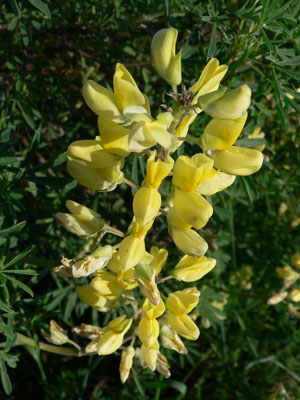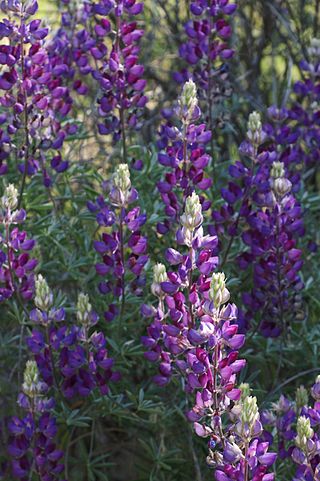
Lupinus polyphyllus, the large-leaved lupine, big-leaved lupine, many-leaved lupine, blue-pod lupine, or, primarily in cultivation, garden lupin, is a species of lupine (lupin) native to western North America from southern Alaska and British Columbia and western Wyoming, and south to Utah and California. It commonly grows along streams and creeks, preferring moist habitats.

Lupinus, commonly known as lupin, lupine, or regionally bluebonnet etc., is a genus of plants in the legume family Fabaceae. The genus includes over 199 species, with centers of diversity in North and South America. Smaller centers occur in North Africa and the Mediterranean. They are widely cultivated, both as a food source and as ornamental plants, but are invasive to some areas.

Lupinus arboreus, the yellow bush lupine (US) or tree lupin (UK), is a species of flowering plant in the legume family Fabaceae.

Lupinus microcarpus, the wide-bannered lupine or chick lupine, is a species of lupine native to western North America from southwestern British Columbia south through Oregon and California, including the Mojave Desert, and into Baja California. There is also a disjunct population in South America, with locations in central Chile and western Argentina.

Lupinine is a quinolizidine alkaloid present in the genus Lupinus of the flowering plant family Fabaceae. The scientific literature contains many reports on the isolation and synthesis of this compound as well as a vast number of studies on its biosynthesis from its natural precursor, lysine. Studies have shown that lupinine hydrochloride is a mildly toxic acetylcholinesterase inhibitor and that lupinine has an inhibitory effect on acetylcholine receptors. The characteristically bitter taste of lupin beans, which come from the seeds of Lupinus plants, is attributable to the quinolizidine alkaloids which they contain, rendering them unsuitable for human and animal consumption unless handled properly. However, because lupin beans have potential nutritional value due to their high protein content, efforts have been made to reduce their alkaloid content through the development of "sweet" varieties of Lupinus.

Lupinus texensis, the Texas bluebonnet or Texas lupine is a species of lupine found in Texas, Louisiana, Arkansas and the Mexican states of Coahuila, Nuevo León, and Tamaulipas. With other related species of lupines also called bluebonnets, it is the state flower of Texas.

Lupinus nanus, the sky lupine, field lupine, dwarf lupin, ocean-blue lupine or Douglas' annual lupine, is a species of lupine native to the western United States. It is found natively in California, Nevada, and on Steens Mountain in eastern Oregon. It tends to grow on slopes and in open or disturbed areas below 1300 meters.

Lupinus albus, commonly known as the white lupin or field lupine, is a member of the genus Lupinus in the family Fabaceae. It is a traditional pulse cultivated in the Mediterranean region.

Lupinus luteus is known as annual yellow-lupin, European yellow lupin or yellow lupin. It is native to the Mediterranean region of Southern Europe.

Lupinus perennis is a flowering plant in the family Fabaceae.

Lupinus succulentus is a species of lupine known by the common names hollowleaf annual lupine, arroyo lupine, and succulent lupine.

Lupinus nootkatensis, the Nootka lupine, is a perennial plant of the genus Lupinus in the legume family, Fabaceae. It is native to North America. The Nootka lupine grows up to 60 cm tall. Late in the 18th century it was first introduced to Europe.

Lupinus albifrons, silver lupine, white-leaf bush lupine, or evergreen lupine, is a species of lupine (lupin). It is native to California and Oregon, where it grows along the coast and in dry and open meadows, prairies and forest clearings. It is a member of several plant communities, including coastal sage scrub, chaparral, northern coastal scrub, foothill woodland, and yellow pine forest.
Lupinus saxosus is a species of lupine known by the common name rock lupine. It is certainly native to eastern Washington, eastern Oregon, and the northeast corner of California,where it grows in sagebrush and other habitat. It may also be native to Idaho and Nevada.

Lupinus aridorum is a rare species of lupine known by the common name scrub lupine. It is endemic to Florida in the United States, where there were 10 known populations remaining in 2003. Fewer than 6000 individual plants were counted. It is threatened by the loss and degradation of its habitat. The scrub lupine is a federally listed endangered species of the United States.

Lupinus sericeus is a species of flowering plant in the legume family known by the common name silky lupine or Pursh's silky lupine. It is native to western North America from British Columbia to Arizona and east to Alberta and Colorado.

Anagyrine is a teratogenic alkaloid first isolated from Anagyris foetida in the year 1885 by French biologists Hardy and Gallois. A. foetida, the Stinking Bean Trefoil, is a highly toxic shrub native to the Mediterranean region, with a long history of use in folk medicine. In the year 1939 Anagyrine was found by James Fitton Couch to be identical to an alkaloid present in many species belonging to the plant genus Lupinus (lupins). The toxin can cause crooked calf disease if a cow ingests the plant during certain periods of pregnancy.
Lupinus mexicanus, also known as the Mexican lupin, is a species of lupine native to Mexico and introduced in Malawi, Tanzania, and Zimbabwe. Some sources say it was introduced to India, too.
Lupinus prunophilus, commonly known as the hairy bigleaf lupine or chokecherry lupin, is a medium-sized herbaceous plant that grows in the Great Basin and other parts of the U.S. interior between the Sierra-Nevada and the Rockies. It is a close relative and very similar to Lupinus polyphyllus and is considered a subspecies by some botanists.

Lupinus caudatus is a widespread species of wildflower in genus Lupinus from western North America known by the common names tailcup lupin and spurred lupin. It is distinctive for the short spur on its purple-blue flowers, for which it is named. Because of its wide distribution and toxicity it commonly causes poisonings of susceptible livestock such as horses, cattle, and sheep, though it is eaten without harm by wild herbivores like deer and elk. It is generally found from the Coastal Ranges and Sierra Nevada Mountains in the west to the Rocky Mountains in the east.
















